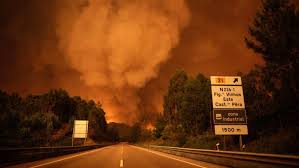Portugal Safety and Security Report Wednesday 19th June 2024
Good morning everyone. We start with commemorating the Pedrógão Grande fires from 17th to 24th June 2017 when 66 people lost their lives – the worst fires in Portugal’s history,
 The first report into the Pedrógrão Grande fire was completed in just 4 months and the lessons learned, served the basis of many improvements that have been made since then. Our association Safe Communities Portugal became involved in various working groups and meetings with various government officials, including from the newly formed AGIF, shortly afterwards to help develop some of the many recommendations that had been made.
The first report into the Pedrógrão Grande fire was completed in just 4 months and the lessons learned, served the basis of many improvements that have been made since then. Our association Safe Communities Portugal became involved in various working groups and meetings with various government officials, including from the newly formed AGIF, shortly afterwards to help develop some of the many recommendations that had been made.
Seven years later, the recent public interventions by local and national politicians on the occasion of the celebrations of Portugal Day, or the testimony of residents in the three municipalities most affected by the fires, coincide in the analysis that much still needs to be done in those territories in the centre of the country.
Depopulation, an ageing population, a lack of qualified jobs or forest management, communication failures, dangerous roads or deficient public services are, after all, problems that coincide with dozens of municipalities in the Portuguese interior.
The need for cohesion in the national territory is constantly reiterated, but in those territories this goal is slow to be fulfilled. The aggravating factor is that in the Pedrógão Grande area there was a deadly fire the likes of which had never been seen before, and as a result of its consequences, there are those who, to this day, are still waiting for a new house – at least four first homes are yet to be rebuilt – or who continue to seek medical help in the area of mental health, because there are psychological traumas that do not go away and the sound of a fire engine siren heard throughout the mountains is causing the population to become restless once again.
Unfortunately we still here of examples where private land has not been cleaned and also government land, particularly roadsides in high risk areas. With increasing extreme weather conditions such as high temperatures, it is very easy for fires to start (by human hand) and to spread due to increased intensity. Each day we publish on this page the fire danger for each municipality as well as the Fire Weather Index (FWI) which is an indicator of the potential intensity of any fires which start.
This is very important as when the FWI level reaches 50 it is “extreme” which means it is extremely difficult to suppress by firefighters, and the only way the fire can be extinguished is by precipitation or a decrease in winds.
With that our team wishes you an enjoyable week ahead
News
AIMA processed 110,000 immigrant residency applications last month
The Migration and Asylum Agency processed 110,000 immigrant residency applications last month, a third of which were submitted by Brazilians.
In the first days of May, immigrants entering the country until April 30th who had presented the so-called expression of interest began to be notified by email to pay a mandatory fee to regularize the residence process.
 The aim of the Migration and Asylum Agency (AIMA) was to speed up the many applications on the waiting list, but the immediate effect was the opposite. At the doors of AIMA, in Lisbon and Porto, long queues formed, day and night, with dozens of migrants complaining about the lack of explanations and, above all, about the delay in the processes, which in some cases had already lasted several years.
The aim of the Migration and Asylum Agency (AIMA) was to speed up the many applications on the waiting list, but the immediate effect was the opposite. At the doors of AIMA, in Lisbon and Porto, long queues formed, day and night, with dozens of migrants complaining about the lack of explanations and, above all, about the delay in the processes, which in some cases had already lasted several years.
It is now known that, in just over a month, 110,000 pending requests were processed. The AIMA data was released this Monday by Diário de Notícias Brasil, which also states that a third of those who paid the fee, equivalent to 33 thousand people, are Brazilians.
The 110,000 requests processed represent a decrease in the approximately 400,000 processes inherited from the former SEF (Foreigners and Borders Service). The notification of immigrants took place before the end of the expression of interest announced two weeks ago by the current government.
New bridge over the Guadiana awaiting the Spanish government
The Andalusian Junta expressed support for the connection between Alcoutim and Sanlúcar and will request a meeting with the Madrid executive and Portuguese authorities. Funded by the PRR, the project must be completed by June 2026. The Iberian Summit scheduled for October could unlock the process
 When we talk about projects that are taking place in Portugal, the first idea that will come to most people’s minds is that of the new Lisbon airport. But this is by no means a unique case. Further south, there has been talk for decades of a new bridge over the Guadiana River, between Alcoutim, in the Algarve, and Sanlúcar, in Andalusia.
When we talk about projects that are taking place in Portugal, the first idea that will come to most people’s minds is that of the new Lisbon airport. But this is by no means a unique case. Further south, there has been talk for decades of a new bridge over the Guadiana River, between Alcoutim, in the Algarve, and Sanlúcar, in Andalusia.
The project is now included in the PRR but, to be built with these funds, it must be ready by June 2026. And, with time passing, the danger of it not being implemented begins to loom. And it’s Spain’s fault.
There are more and more Portuguese people wanting to donate their bodies to science
More and more Portuguese people declare that they want to donate their bodies to science after death. After a sharp drop in 2020, the number of donation intentions is back to pre-pandemic values.
For medical students and researchers, dissecting a human cadaver is a privilege, but studying the dead depends on the initiative of the living. The number of body donations for scientific purposes dropped sharply with the arrival of the pandemic, but has since increased and is now back to pre-COVID-19 levels.
According to Jornal de Notícias, in the last five years, public colleges registered 4,478 intention processes. In other words, almost 4,500 Portuguese people formally expressed their desire to donate their bodies for scientific purposes upon death. As for dead bodies actually received, there were 618 between 2019 and 2023.
 The Portuguese Anatomical Society is grateful for the generosity of donors, who contribute to the medical training of thousands of students and health professionals. However, experts point out gaps in the law that regulates donations, which dates back to 1999. For example, there is a lack of standardization in which situations faculties can refuse a body or how cadavers should be preserved.
The Portuguese Anatomical Society is grateful for the generosity of donors, who contribute to the medical training of thousands of students and health professionals. However, experts point out gaps in the law that regulates donations, which dates back to 1999. For example, there is a lack of standardization in which situations faculties can refuse a body or how cadavers should be preserved.
The process for expressing a wish to donate is simple. The future donor, who is of legal age, fills out a form provided by the medical school of his or her choice, whether public or private. The declaration must be notarized, but, as a general rule, all costs are borne by the school. The wish must also be shared with family and friends, who will have to inform the institution of any possible death.
Most colleges also have agreements with funeral agencies that allow them to guarantee all the celebrations that the family desires, or that the family requested during their lifetime, before handing over the body to science.
